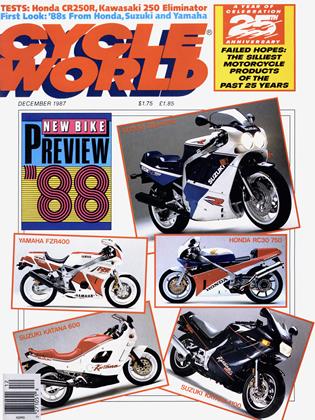MOTOVIDEO SUPERBOWL OF MOTOCROSS 1986,1978 AND 1976 HIGHLIGHTS
EVALUATION
10 YEARS BEFORE—AND AFTER
SUPERCROSS GOT ITS START SOME 15 years ago, when shrewd promoters winnowed the “out" from outdoor motocross, repackaged the remainder and served it all up in the relatively comfy confines of a football/baseball stadium. And the one race that epitomizes this sport is the original supercross event, the Superbowl of Motocross, held since 1972 in the Los Angeles Memorial Coliseum, just a gunshot’s distance from downtown L.A.
Since then. Supercross—and the Superbowl —have been through some changes. And Motovideo (31672 Pacific Coast Highway, South Laguna, CA 92677; [714] 499-6200) has a pair of videotapes that offer a glimpse of those changes, as seen in the 1978 Superbowl of Motocross and 1976 Highlights ($29.95), and the 1986 Superbowl of Motocross ($49.95).
Among those differences are the riders. Oh, they're still fearless young athletes; what's changed is the public face they present. For instance, at the '76 Superbowl, there was reigning 500 class champ Jimmy Weinert, espousing pyramid power, as he lounged between motos under a makeshift pyramid replica. It was a show, of course, something to psych the competition, but it also revealed the loopiness that occasionally characterized Weinert—and other riders of the era—which would seem out of place among today's polished young pros.
The nature of both the machinery and the tracks has changed radically, too. Thanks to a rule change for 1986, modified production-based bikes till the starting lines, where once the factories fielded exotic, one-off toolroom specials. And the three 30-minute-moto format evident in the '76 Highlights tape gave way to a Class-C style format, with heat races, semis, a last-chance qualifier and a main event. The tracks themselves have gotten more challenging, as well. Whereas the ’76/’78 Superbowl tape shows riders staying comparatively low off the jumps, in the '86 tape you see them achieve near-orbit altitude over double, triple and quad jumps.
You see them bite the big one, too. The increasingly formidable obstacles make for a crowd-pleasing show, but they sometimes exact a price. And some riders are unwilling to pay, such as Bob Hannah; before the '86 Superbowl even began, Hannah, the winningest rider in American motocross, gave notice that he didn't intend to jump the quads or the triples in a single frenzied leap.
It cost him, too, as he struggled through his heat race, crashed in his semi and came up short in the lastchance qualifier. Quite a contrast from the Hannah at the '78 Superbowl, at the height of his powers, putting on an unforgettable come-from-behind ride. By comparison, in the '86 tape the fire and drive that once characterized Hannah seem to have been inherited by soonto-be Supercross champ Rick Johnson.
Both videos also reveal the telling progress 10 years makes in just videotaping such a race. Production qualities for the '86 Superbowl tape are vastly superior to those for the older events. The announcing, though, ranges from hyperbolic descriptions of man and machine in the ’76/’78 video, to the frenzied prattle accompanying the '86 race. The “Highlights” title is an accurate one, too, for the '76 'bowl video, which covers only 1 Vi of the three motos.
In fact, separately, as individual races, neither Superbowl tape ($39.95 each) is particularly compelling. Instead, they’re more important taken together. They serve as moving snapshots, if you will, providing entertainment with a bit of history on a uniquely American form of motorsport.
 View Full Issue
View Full Issue
More From This Issue
-
 Editorial
EditorialIdol Speculation
December 1987 By Paul Dean -
 At Large
At LargeService Bulletins
December 1987 By Steven L. Thompson -
 Leanings
LeaningsDesmo Fever
December 1987 By Peter Egan -
 Letters
LettersLetters
December 1987 -
 Roundup
RoundupThe $20, All-Or-Nothing Gamble
December 1987 By David Edwards -
 Roundup
RoundupRallying In the Rockies
December 1987 By Bill Stermer





